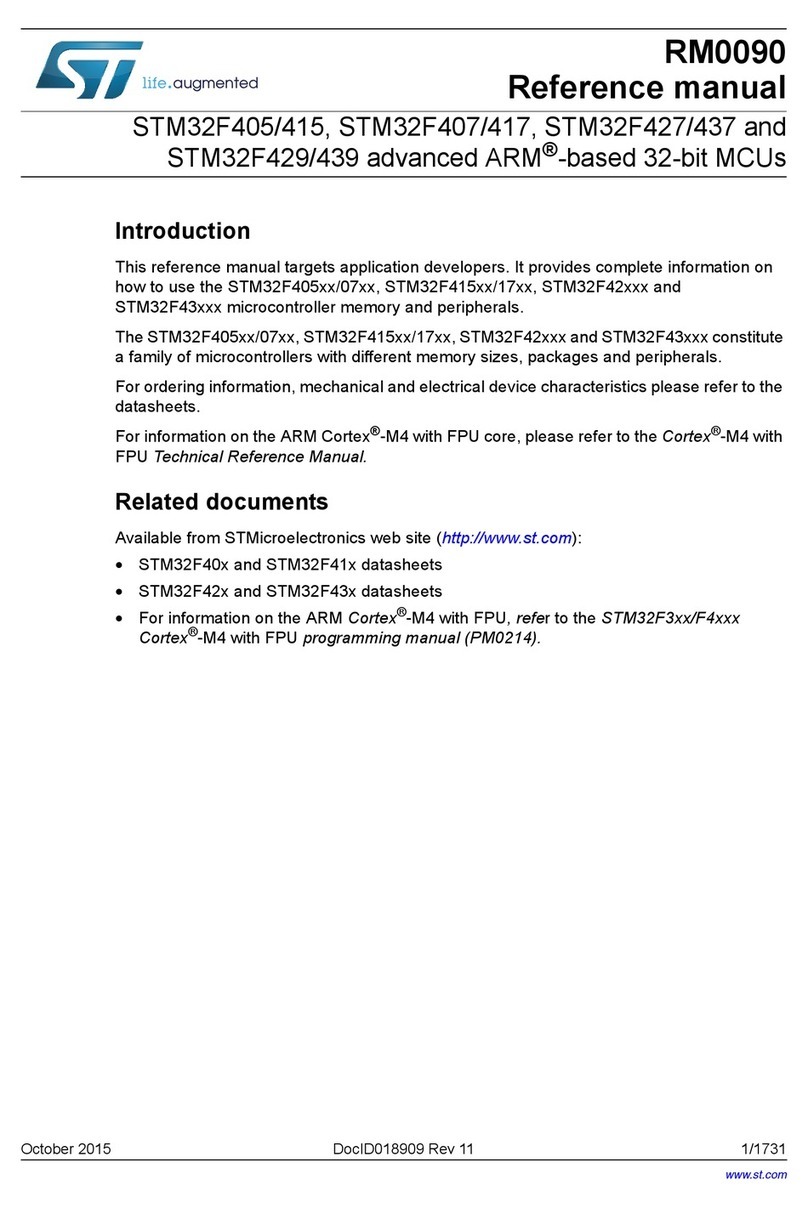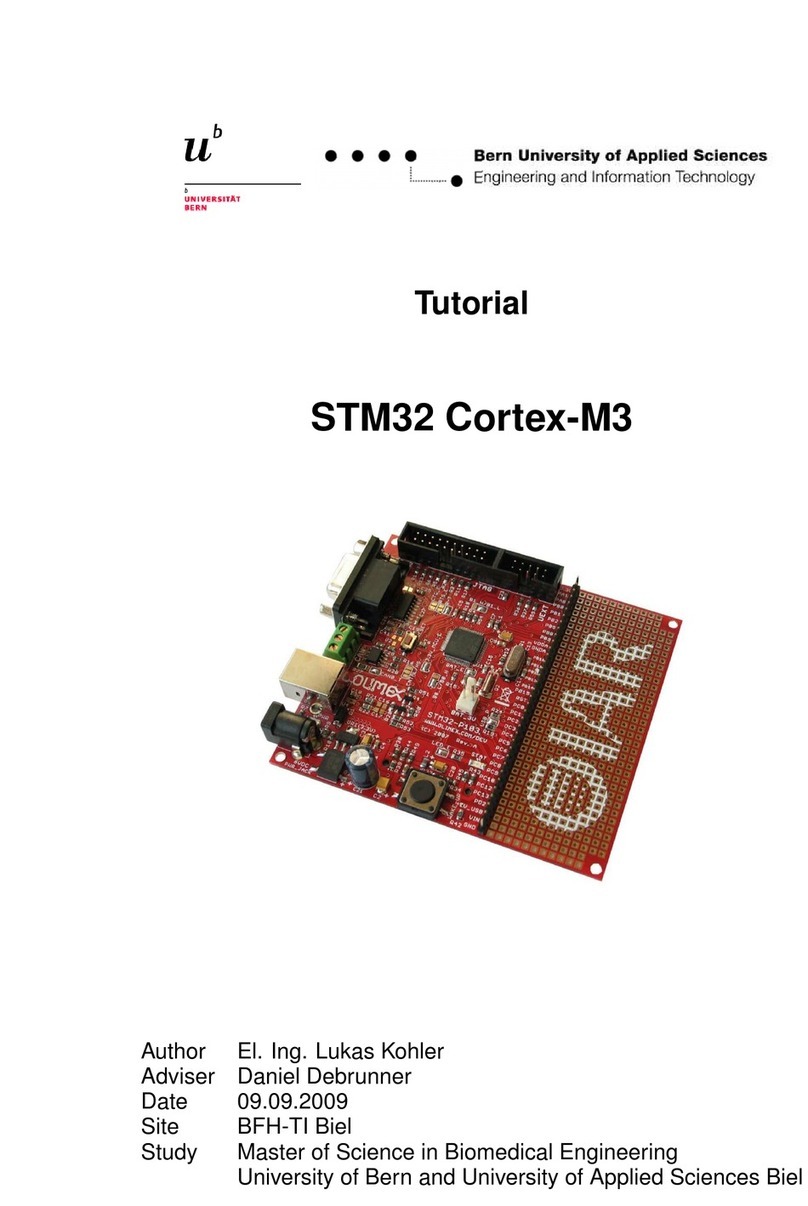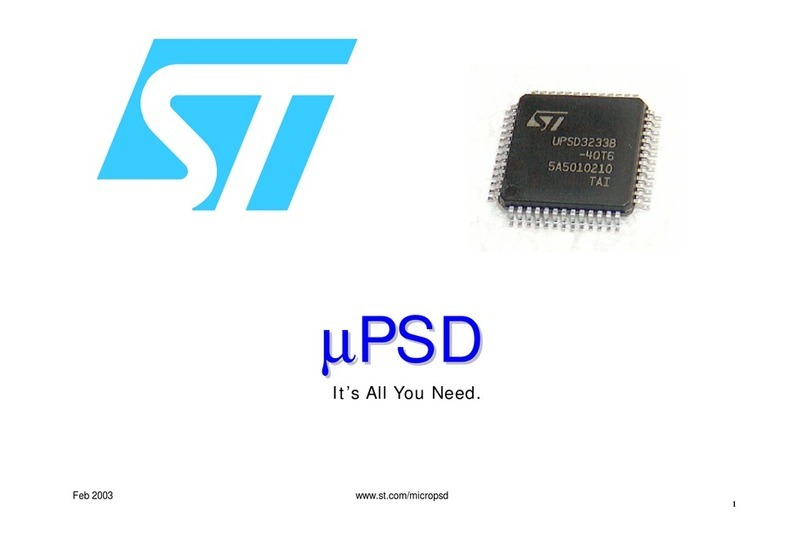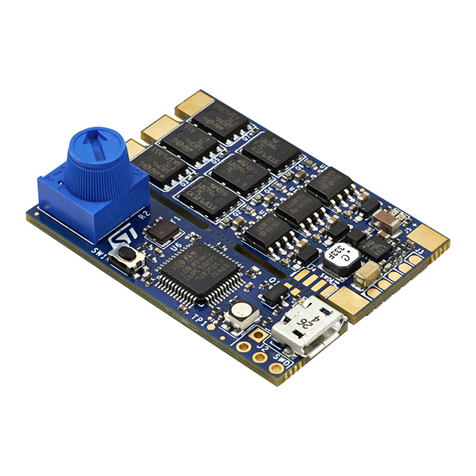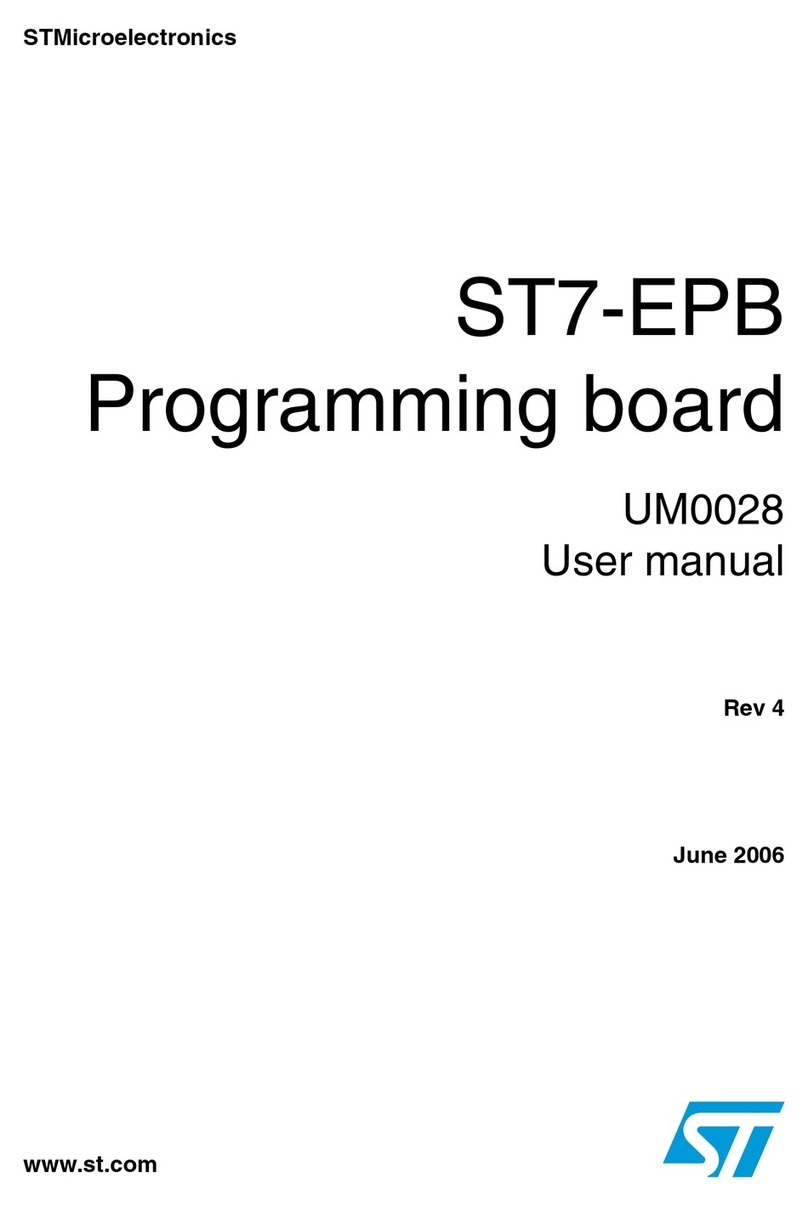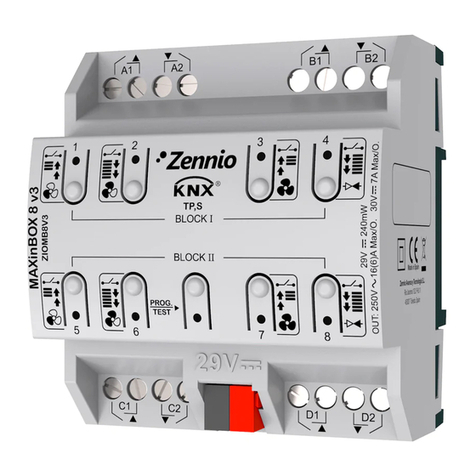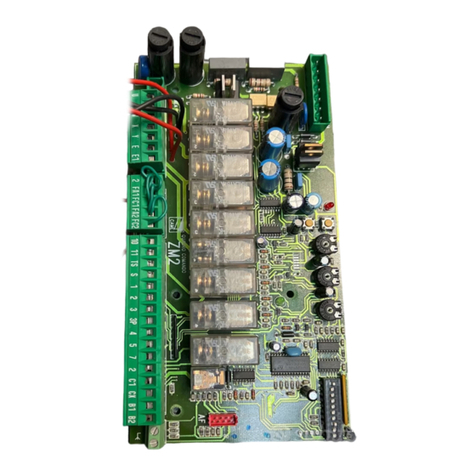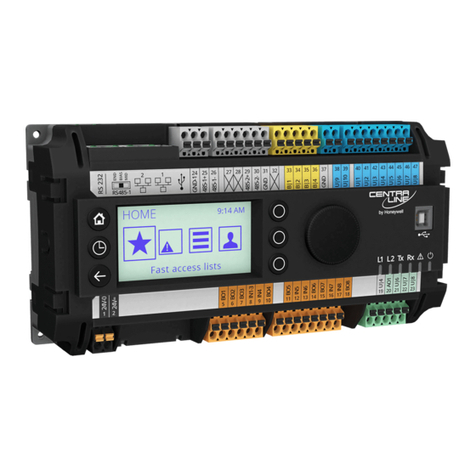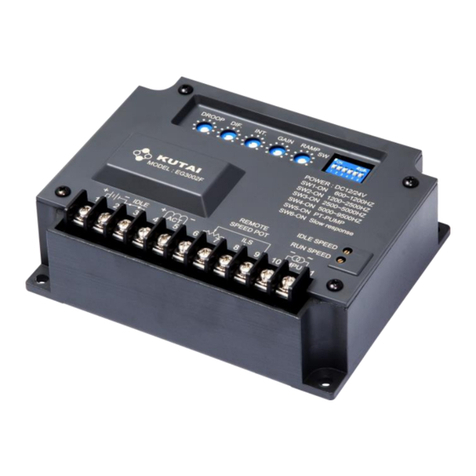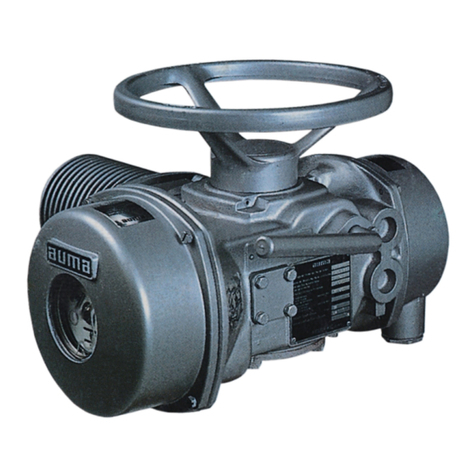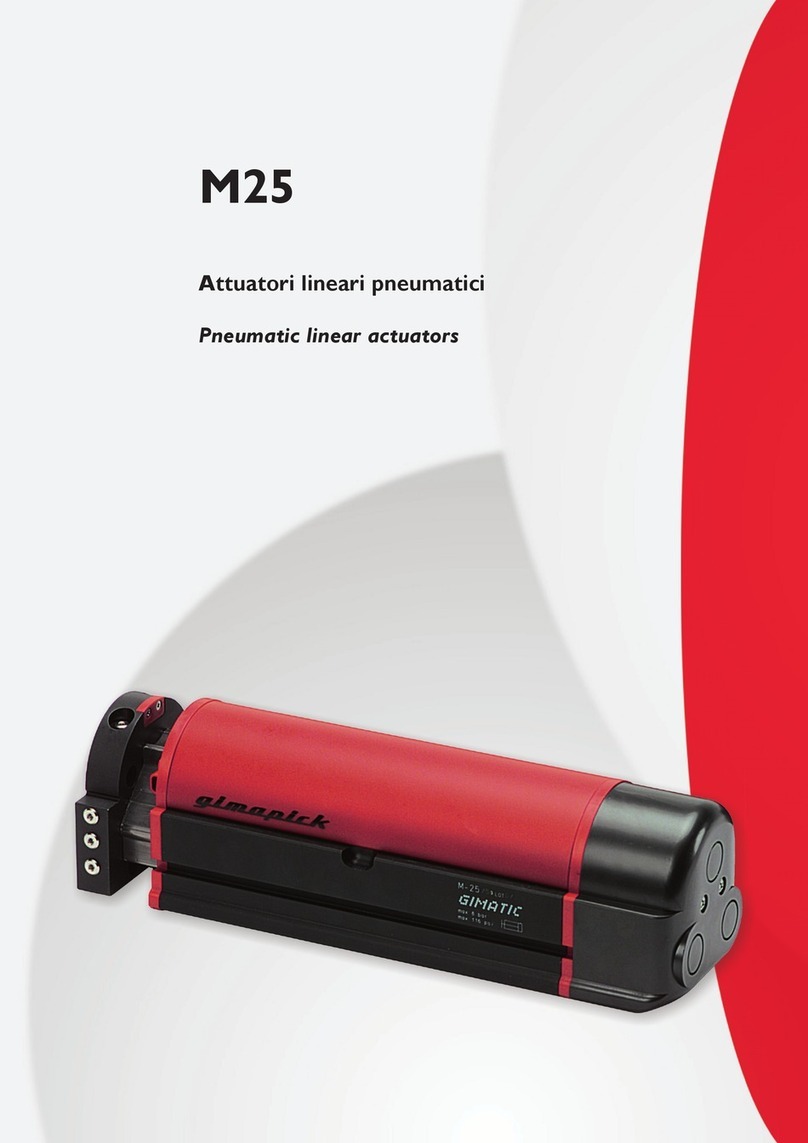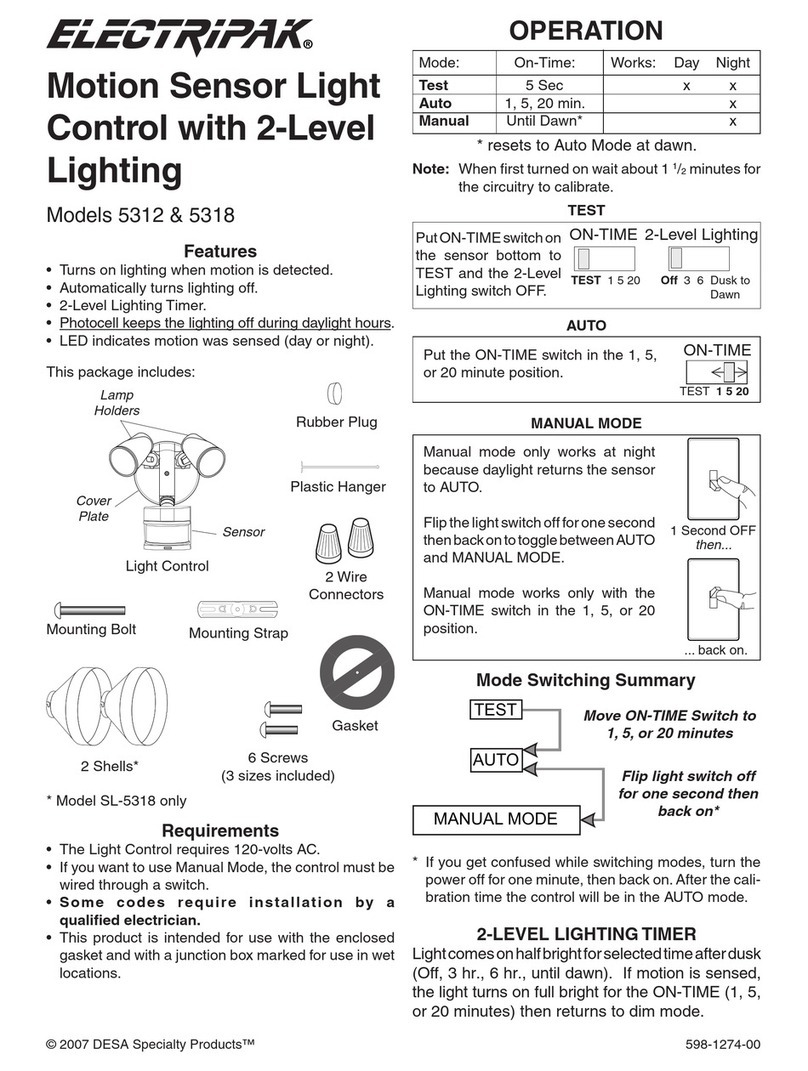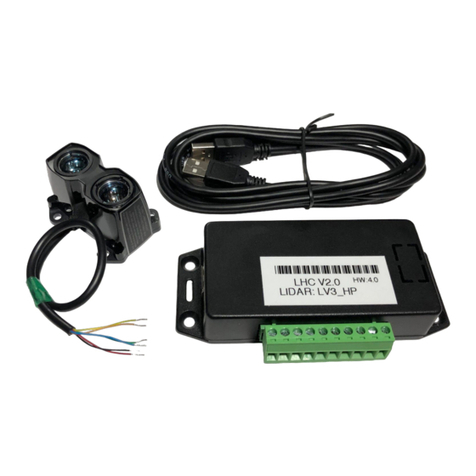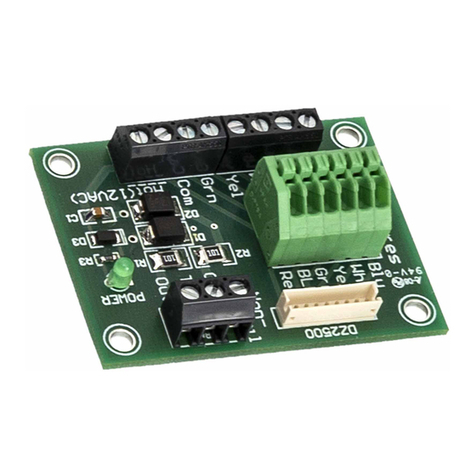STMicroelectronics STLUX385A User manual

May 2014 DocID026248 Rev 1 1/21
UM1753
User manual
Description of STLUX385A peripheral library
Introduction
This user manual provides complete information for SW developers on the STLUX385A
library, a library of APIs useful to get familiar developing applications for the STLUX385A
digital controller and its peripherals.
The STLUX385A is an STMicroelectronics®digital device tailored for lighting applications.
The heart of the STLUX is the SMED (“State Machine Event Driven”) technology which
allows the device to operate several independently configurable PWM clocks with up to
1.3 ns resolution. A SMED is a powerful autonomous state machine which is programmed to
react to both external and internal events and may evolve without any software intervention.
The tools provided by this Kit will help you understand the SMEDs and how to program them
in your applications.
SMEDs are configured and programmed via the STLUX internal low-power microcontroller
(STM8). This manual describes the tools provided in this kit.
www.st.com

Contents UM1753
2/21 DocID026248 Rev 1
Contents
1 Reference documents . . . . . . . . . . . . . . . . . . . . . . . . . . . . . . . . . . . . . . . . 4
2 Acronyms . . . . . . . . . . . . . . . . . . . . . . . . . . . . . . . . . . . . . . . . . . . . . . . . . . 5
3 STLUX library . . . . . . . . . . . . . . . . . . . . . . . . . . . . . . . . . . . . . . . . . . . . . . . 7
3.1 Introduction . . . . . . . . . . . . . . . . . . . . . . . . . . . . . . . . . . . . . . . . . . . . . . . . 7
3.2 STLUX385A clock (stlux_clk) . . . . . . . . . . . . . . . . . . . . . . . . . . . . . . . . . . . 7
3.3 STLUX385A SMEDs (stlux_smed) . . . . . . . . . . . . . . . . . . . . . . . . . . . . . . 10
3.4 STLUX385A analog comparator unit (stlux_acu) . . . . . . . . . . . . . . . . . . . .11
3.5 STLUX385A analog-to-digital converter (stlux_adc) . . . . . . . . . . . . . . . . .11
3.6 STLUX385A system timer (stlux_stmr) . . . . . . . . . . . . . . . . . . . . . . . . . . 13
3.7 STLUX385A general purpose I/O (stlux_gpio) . . . . . . . . . . . . . . . . . . . . . 15
3.8 STLUX385A auxiliary timer (stlux_atm) . . . . . . . . . . . . . . . . . . . . . . . . . . 16
3.9 STLUX385A auto wake-up unit (stlux_awu) . . . . . . . . . . . . . . . . . . . . . . . 16
3.10 STLUX385A universal asynchronous receiver/transmitter (stlux_uart) . . 17
4 Revision history . . . . . . . . . . . . . . . . . . . . . . . . . . . . . . . . . . . . . . . . . . . 20

DocID026248 Rev 1 3/21
UM1753 List of tables
21
List of tables
Table 1. List of acronyms . . . . . . . . . . . . . . . . . . . . . . . . . . . . . . . . . . . . . . . . . . . . . . . . . . . . . . . . . . 5
Table 2. STLUX385A clock. . . . . . . . . . . . . . . . . . . . . . . . . . . . . . . . . . . . . . . . . . . . . . . . . . . . . . . . . 7
Table 3. STLUX385A SMEDs. . . . . . . . . . . . . . . . . . . . . . . . . . . . . . . . . . . . . . . . . . . . . . . . . . . . . . 10
Table 4. STLUX385A analog comparator unit . . . . . . . . . . . . . . . . . . . . . . . . . . . . . . . . . . . . . . . . . 11
Table 5. STLUX385A analog-to-digital converter . . . . . . . . . . . . . . . . . . . . . . . . . . . . . . . . . . . . . . . 11
Table 6. STLUX385A system timer . . . . . . . . . . . . . . . . . . . . . . . . . . . . . . . . . . . . . . . . . . . . . . . . . 13
Table 7. STLUX385A general purpose I/O . . . . . . . . . . . . . . . . . . . . . . . . . . . . . . . . . . . . . . . . . . . . 15
Table 8. STLUX385A auxiliary timer. . . . . . . . . . . . . . . . . . . . . . . . . . . . . . . . . . . . . . . . . . . . . . . . . 16
Table 9. STLUX385A auto wake-up unit . . . . . . . . . . . . . . . . . . . . . . . . . . . . . . . . . . . . . . . . . . . . . 16
Table 10. STLUX385A universal asynchronous receiver/transmitter . . . . . . . . . . . . . . . . . . . . . . . . . 17
Table 11. Document revision history . . . . . . . . . . . . . . . . . . . . . . . . . . . . . . . . . . . . . . . . . . . . . . . . . 20

Reference documents UM1753
4/21 DocID026248 Rev 1
1 Reference documents
For hardware information on the STLUX385A controller and product specific SMED
configuration, please refer to the STLUX385A product datasheet.
For information on programming, erasing and protection of the internal Flash memory
please refer to the STM8 Flash programming manual (PM0047).
For information about the debug and SWIM (single-wire interface module) refer to the
STM8 SWIM communication protocol and debug module user manual (UM0470).
For information on the STM8 core and assembler instruction please refer to the STM8
CPU programming manual (PM0044).
For information on the SMED configurator please refer to the UM1760 “STLUX™
SMED configurator 1.0” user manual.

DocID026248 Rev 1 5/21
UM1753 Acronyms
21
2 Acronyms
A list of acronyms used in this document:
Table 1. List of acronyms
Acronym Description
ACU Analog comparator unit
ADC Analog-to-digital converter
ATM Auxiliary timer
AWU Auto wake-up unit
BL Bootloader - used to load the user program without the emulator
CCO Configurable clock output
CKC Clock control unit
CKM Clock master
CPU Central processing unit
CSS Clock security system
DAC Digital-to-analog converter
DALI Digital addressable lighting interface
ECC Error Correction Code
FSM Finite state machine
FW Firmware loaded and running on the CPU
GPIO General purpose input output
HSE High-speed external crystal - ceramic resonator
HSI High-speed internal RC oscillator
I2C Inter-integrated circuit interface
IAP In-application programming
ICP In-circuit programming
ITC Interrupt controller
IWDG Independent watchdog
LSI Low-speed Internal RC oscillator
MCU Microprocessor central unit
MSC Miscellaneous
PM Power management
RFU Reserved for future use
ROP Read-out protection
RST Reset control unit
RTC Real-time clock

Acronyms UM1753
6/21 DocID026248 Rev 1
SMED State machine event driven
STMR System timer
SW Software, is the firmware loaded and running on the CPU (synonymous of FW)
SWI Clock switch interrupt
SWIM Single-wire interface module
UART Universal asynchronous receiver/transmitter
WWDG Window watchdog
Table 1. List of acronyms (continued)
Acronym Description

DocID026248 Rev 1 7/21
UM1753 STLUX library
21
3 STLUX library
3.1 Introduction
The STLUX385A library is a collection of APIs aiming to simplify the usage of the STLUX
SMEDs and peripherals to application developers. Each collection of APIs is dedicated to
a specific device or functionality and named so “stlux_xxx” where “xxx” stands for the name
of the peripheral. The library is developed using the C language compatible with the IAR™
and Raisonance tools and is composed of the “stlux_xxx.c” and “stlux_xxx.h” relative files to
be included in your application.
3.2 STLUX385A clock (stlux_clk)
Table 2. STLUX385A clock
Header Input parameters Output
parameters Functionality
CLK_Reset
Sets the clock internal
registers to their default
initialization values.
CLK_HSECmd NewState: it can be ENABLE or
DISABLE. Enables/disables HSE.
CLK_HSICmd NewState: it can be ENABLE or
DISABLE. Enables/disables HSI.
CLK_LSICmd NewState: it can be ENABLE or
DISABLE. Enables/disables LSI.
CLK_CCOCmd NewState: it can be ENABLE or
DISABLE. Enables/disables CCO.
CLK_ClockSwitchCmd NewState: it can be ENABLE or
DISABLE.
Manually starts/stops the
clock switch execution.
CLK_FastHaltWakeUpCmd NewState: it can be ENABLE or
DISABLE.
When enabled, the HSI
oscillator is automatically
switched-on and selected
as a next master clock
when resuming from
HALT/active-halt modes.
CLK_SlowActiveHaltWakeUpCmd NewState can be ENABLE or
DISABLE.
Configures the slow active-
halt wakeup.
CLK_PeripheralClockConfig
CLK_Peripheral can be one of
the following peripherals: I2C,
GPIO0, UART, DALI, STMR,
GPIO1, AWU, ADC, SMEDx,
MSC.
NewState can be ENABLE or
DISABLE.
Enables/disables the
specified peripheral CLK.

STLUX library UM1753
8/21 DocID026248 Rev 1
CLK_ClockSwitchConfig
CLK_SwitchMode: the clock
switch mode can be MANUAL
or AUTOMATIC.
CLK_NewClock: the new clock
source can be HSI/LSI/HSE.
ITState can be ENABLE or
DISABLE.
CLK_CurrentClockState can be
ENABLE or DISABLE.
ErrorStatus
reports ERROR
or SUCCESS
according to the
operation result.
This function configures the
clock switch from a clock
source to another.
CLK_HSIPrescalerConfig HSIPrescaler specifies the
HIS/CPU clock divider to apply.
This function configures the
HSI or CPU clock dividers.
CLK_ITConfig
CLK_IT specifies the interrupt
sources. They can be the CSS
or the SWI.
NewState can be ENABLE or
DISABLE.
This function
enables/disables the
specified CLK interrupts.
CLK_SYSCLKConfig CLK_Prescaler specifies the
HIS/CPU clock divider to apply.
This function configures the
HSI or CPU clock dividers.
CLK_SWIMConfig
CLK_SWIMDivider specifies
the SWIM clock divider to apply.
It can be divided by 1 or 2.
This function configures the
SWIM clock frequency on
the fly.
CLK_ClockSecuritySystemEnable This function enables the
CSS.
CLK_SYSCLKEmergencyClear
This function reset SWBSY
flag in order to reset clock
switch operations (target
oscillator is broken,
stabilization is longing too
much, etc.). If at the same
time software attempts to
set SWEN and clear
SWBSY, SWBSY action
takes precedence.
CLK_AdjustHSICalibrationValue CLK_HSICalibrationValue is the
calibration trimming value.
This function adjusts the
HSI calibration value.
CLK_GetClockFreq
This function returns the
frequency of the currently
used on chip clock.
CLK_GetSYSCLKSource
Returns the clock source
currently used as system
clock.
CLK_GetFlagStatus CLK_FLAG is the clock status
flag to be checked.
FlagStatus is the
current flag
status value.
Checks whether the
specified CLK flag is set or
not.
Table 2. STLUX385A clock (continued)
Header Input parameters Output
parameters Functionality

DocID026248 Rev 1 9/21
UM1753 STLUX library
21
CLK_GetITStatus CLK_IT specifies the CLK
interrupt.
ITStatus is the
current status
for the interrupt.
Checks whether the
specified CLK interrupt has
is enabled or not.
CLK_ClearITPendingBit CLK_IT specifies the CLK
interrupt.
Clears the CLK's interrupt
pending bits.
CLK_PLLConfig
CLK_PLL_Source specifies the
clock source for the PLL. It can
be HSI or HSE.
CLK_PLL_DIVPRES is the
division factor for PLL selected
clock.
This function sets the clock
source for PLL.
CLK_PLLCmd NewState can be ENABLE or
DISABLE.
This function enables or
disables PLL.
CLK_CCOConfig
CLK_CCO specifies the clock
source for the CCO. It can be
one of the following sources:
HIS, LSI, HSE, PLL, CPU,
CKM, SMEDx, ADC, EEPROM,
AWU, prescaled PLL.
CLK_CCODIVR is the division
factor n for the CCO clock,
CLKCCO = CLK / (n + 1).
This function sets the clock
source for the CCO clock.
CLK_ADCConfig
CLK_ADC_Source specifies
the clock source for the ADC. It
can be one of the following
peripherals: HSI, PLL, LSI,
HSE.
CLK_ADC_DIV is the division
factor for PLL selected clock.
CLKADC = CLKSEL / (n+1).
This function sets the clock
source for the ADC.
CLK_AWUConfig
CLK_AWU_DIVIDER is the
division factor for the AWU
clock. It can be a power of two
ranging from 1 to 256.
This function configures the
AWU clock.
CLK_SMEDConfig
CLK_SMD selects the SMEDx
clock to be configured.
Source specifies the clock
source for the SMEDx. It can be
one of the following peripherals:
HSI, PLL, LSI, HSE.
Prescaler is the division factor
for the SMEDx clock. It can be
a power of two ranging from
1 to 128.
This function configures the
SMEDS clock.
Table 2. STLUX385A clock (continued)
Header Input parameters Output
parameters Functionality

STLUX library UM1753
10/21 DocID026248 Rev 1
3.3 STLUX385A SMEDs (stlux_smed)
Table 3. STLUX385A SMEDs
Header Input parameters Output parameters Functionality
SMED_Start SMEDx is the SMED to be started. This function makes the
SMEDx start running.
SMED_Stop SMEDx is the SMED to be
stopped.
This function makes the
SMEDx stop running.
SMED_SetTime
SMEDx is the SMED which time
must be set.
TimeRegister is the status for which
the time must be set. The status
can be T0, T1, T2 or T3.
Value is the time value to be set.
It returns zero in case
of unsuccessful
operation due to
pending time
validation, one
otherwise.
Sets the time value to
the status TimeRegister
for the selected SMEDx.
SMED_ValidateTimeValues
SMEDx is the SMED.
TimeVal is the timer (or the timers)
to be validated.
It returns zero in case
of unsuccessful
operation due to
pending time
validation, one
otherwise.
Validates the settings
previously set with
SMED_SetTime for the
desired SMEDx timers.
SMED_TrigSWEvent
X can assume values ranging from
0 to 7 and corresponds to the SW
event trigger.
This function enables the
SW event triggers for the
SMED FSM.
SMED_Init
This function is defined
as void function by
default and can be
manually generated or
by using the SMED
configurator.

DocID026248 Rev 1 11/21
UM1753 STLUX library
21
3.4 STLUX385A analog comparator unit (stlux_acu)
3.5 STLUX385A analog-to-digital converter (stlux_adc)
Table 4. STLUX385A analog comparator unit
Header Input parameters Output parameters Functionality
ACU_Reset
Sets the ACU internal
registers to their default
initialization values.
ACU_Init Enables the ACU unit and
initializes the compare levels.
ACU_Read ACUx specifies the comparator
peripheral number.
The comparator output
value is returned.
Reads the output of the
comparator x.
ACU_Enable
ACUx specifies the comparator
peripheral number.
CP3_SEL specifies whether
the reference voltage for the
CP3 is internal or external.
Enables the comparator CPx.
In case of CP3, also the
internal/external reference is
specified.
ACU_SetCompareLevel
ACUx specifies the comparator
peripheral number.
DACIN specifies the input
voltage level to be set.
Assigns a specified voltage
level reference to the DACx.
Table 5. STLUX385A analog-to-digital converter
Header Input parameters Output parameters Functionality
ADC_Reset
Sets the ADC internal
registers to their default
initialization values.
ADC_Init
ADC_ConvMode_Init is the conversion
mode. It can be SEQUENCE or
CIRCULAR.
ADC_DataFormat_Init determines
whether the 10 bits data are left or right
aligned.
This function initializes the
ADC sequencer.
ADC_Interrupt
ADC_IntEndConvMode_Interrupt.
ADC_IntEndSeqMode_interrupt
ADC_IntSeqFull_Interrupt
ADC_Sequencer ADC_Channel_Sequencer
ADC_Gain_Sequencer
ADC_Start This function enables ADC
functionality.
ADC_Stop This function disables ADC
functionality.

STLUX library UM1753
12/21 DocID026248 Rev 1
Header Input parameters Output parameters Functionality
ADC_PowerUp
This function performs the
correct power-on sequence
for the ADC (after a power
down to save power).
ADC_PowerDown
This function performs the
correct power-down
sequence for the ADC (to
save power).
ADC_Delay ADC_Delay_Value
This function introduces
a delay in the following
conversion.
ADC_Measure
ADC_Channel_Measure is the channel
number to be activated for the data
acquisition.
ADC_Gain_Measure is the gain factor
to be applied for the conversion.
This function returns
the 16-bit value
coming from the
specified channel.
Given a channel number and
a gain factor, the function
returns a 16-bit value
captured by the ADC.
ADC_GetStatus
The returned data is
the current value of
the ADC status
register.
This function gets the current
ADC status.
ADC_SetStatus
EOS: end of sequence mode bit.HW
sets this bit at the end of conversion
sequence and must be cleared by SW.
This bit is white-clear.
EOC: end of conversion mode bit. HW
sets this bit at the end of each
conversion and must be cleared by SW.
This bit is white-clear.
This function sets the current
ADC status.
Table 5. STLUX385A analog-to-digital converter (continued)

DocID026248 Rev 1 13/21
UM1753 STLUX library
21
3.6 STLUX385A system timer (stlux_stmr)
Table 6. STLUX385A system timer
Header Input parameters Output
parameters Functionality
STMR_Reset
Sets the STMR internal
registers to their default
initialization values.
STMR_TimeBaseInit
STMR_Prescaler specifies the
prescaler division factor for the
STMR. It can be a power of two
ranging from 1 to 128.
STMR_Period specifies the period to
be set for the timer interrupt
generation.
Initializes the STMR time
base unit according to the
specified parameters.
STMR_Cmd NewState: it can be ENABLE or
DISABLE.
This function enables or
disables the STMR
peripheral.
STMR_ITConfig
STMR_IT specifies whether the
STMR interrupt must be enabled or
disabled.
NewState can be ENABLE or
DISABLE.
Enables or disables the
specified STMR
interrupts.
STMR_UpdateDisableConfig Newstate can be ENABLE or
DISABLE.
Enables or disables the
update event for the auto-
reload preload mode.
STMR_UpdateRequestConfig
STMR_UpdateSource specifies
whether the interrupt is generated by
counter overflow only or by registers
update. Possible values are
UPDATESOURCE_GLOBAL and
UPDATESOURCE_REGULAR.
Selects the STMR Update
Request Interrupt source.
STMR_SelectOnePulseMode STMR_OPMode specifies if the one
pulse mode must be activated.
Enables or disables the
one pulse. This mode
makes the counter stop
when the next update
event is triggered.
STMR_PrescalerConfig
Prescaler specifies the prescaler
division factor for the STMR. It can
be a power of two ranging from 1 to
128.
STMR_PSCReloadMode specifies
whether the prescaler is loaded
immediately or at the update event.
This function configures
the STMR prescaler.
STMR_ARRPreloadConfig Newstate can be ENABLE or
DISABLE.
Enables or disables
STMR peripheral on auto-
reload preload enable
register.

STLUX library UM1753
14/21 DocID026248 Rev 1
STMR_GenerateEvent STMR_EventSource enables the
event to be generated.
This function configures
the STMR event to be
generated by SW. The
register is automatically
cleared by HW.
STMR_SetCounter
Counter specifies the counter new
value to be set in the range 0x0000
to 0xFFFF.
Sets the STMR counter
register value.
STMR_SetAutoreload
Auto-reload specifies the auto-reload
new value to be set in the range
0x0000 to 0xFFFF.
Sets the STMR auto-
reload value.
STMR_GetCounter
The returned
value is the
current STMR
counter.
Gets the current STMR
counter value.
STMR_GetPrescaler
The returned
value is the
current STMR
prescaler.
Gets the current STMR
prescaler value.
STMR_GetFlagStatus STMR_FLAG specifies the STMR
status register value.
The returned
value is the
current flag
status. It can be
SET or RESET.
Checks whether the
specified STMR flag is set
or not.
STMR_ClearFlag STMR_FLAG specifies the STMR
status register value.
Clears the STMR status
flag.
STMR_GetITStatus STMR_IT specifies the STMR
interrupt status register value.
The returned
value is the
STMR interrupt
status register.
This function checks
whether an interrupt has
occurred or not.
STMR_ClearITPendingBit STMR_IT specifies the STMR
interrupt status register value.
This function clear the
interrupt pending flag.
Table 6. STLUX385A system timer (continued)
Header Input parameters Output
parameters Functionality

DocID026248 Rev 1 15/21
UM1753 STLUX library
21
3.7 STLUX385A general purpose I/O (stlux_gpio)
Table 7. STLUX385A general purpose I/O
Header Input parameters Output
parameters Functionality
GPIO_Reset GPIOx specifies the GPIO peripheral
number.
Sets the GPIOx internal
registers to their default
initialization values.
GPIO_Init
GPIOx specifies the GPIO peripheral
number.
GPIO_Pin specifies the pins to be
associated to the I/O.
GPIO_Mode specifies one of the possible
GPIO configurations.
Initializes the GPIOx
according to the
specified parameters.
GPIO_Write
GPIOx specifies the GPIO peripheral
number.
PortVal specifies the value to be written to
the port output.
Writes data to the
specified GPIO data
port.
GPIO_WriteHigh
GPIOx specifies the GPIO peripheral
number.
PortPins specifies the pins to be turned high
to the port output
Sets high level to the
specified GPIO pins.
GPIO_WriteLow
GPIOx specifies the GPIO peripheral
number.
PortPins specifies the pins to be turned low
to the port output.
Sets low level to the
specified GPIO pins.
GPIO_WriteReverse
GPIOx specifies the GPIO peripheral
number.
PortPins specifies the pins to be reversed to
the port output.
Writes reverse level to
the specified GPIO
pins.
GPIO_ReadInputData GPIOx specifies the GPIO peripheral
number
This function
returns the
read value.
Reads the specified
GPIO input data port.
GPIO_ReadOutputData GPIOx specifies the GPIO peripheral
number.
This function
returns the
read value.
Reads the specified
GPIO output data port.
GPIO_ReadInputPin
GPIOx specifies the GPIO peripheral
number.
GPIO_Pin specifies the pins to be read
BitStatus Reads the specified
GPIO input data pin.
GPIO_ExternalPullUpConfig
GPIOx specifies the GPIO peripheral
number.
GPIO_Pin specifies the pins to be
configured.
Newstate is the new state of the pull-up
pins. It can be ENABLE or DISABLE.
Configures the external
pull-up on GPIOx pins.

STLUX library UM1753
16/21 DocID026248 Rev 1
3.8 STLUX385A auxiliary timer (stlux_atm)
Table 8. STLUX385A auxiliary timer
3.9 STLUX385A auto wake-up unit (stlux_awu)
Header Input parameters
Output
para-
meters
Functionality
ATM_Reset
Sets the ATM
internal registers to
their default
initialization values.
ATM_Config
CLK_CCO specifies the selected clock source for the CCO
derived clock.
CLK_CCODIVR specifies the frequency division factor for the
CCO derived clock.
IT_LEV specifies the interrupt level sensitivity (high/low) for the
ATM.
IT_SEL specifies the interrupt trigger (source/edge) for the ATM.
IT_TYPE specifies the interrupt Type (IRQ/NMI/Polling) for the
ATM.
Sets the ATM
registers to the
desired
configuration.
ATM_OutDigIn0 NewState can be ENABLE or DISABLE.
Enables or disables
the ATM clock to be
sent to DIGIN(0).
ATM_ITConfig NewState can be ENABLE or DISABLE.
Enables or disables
the ATM to
generate interrupt.
Table 9. STLUX385A auto wake-up unit
Header Input parameters Output parameters Functionality
AWU_Reset
Sets the AWU internal
registers to their default
initialization values.
AWU_Init
AWU_Prescaler specifies the number
of steps to be counted between two
AWU interrupts. It must be a value
ranging from 0 to 62.
AWU_TimeBase specifies the value
of a single step.
Initializes the AWU
peripheral according to the
specified parameters.
AWU_Enable NewState can be ENABLE or
DISABLE.
Enables or disables the
AWU peripheral.
AWU_IdleModeEnable
Configures AWU in Idle
mode to reduce power
consumption.
AWU_GetStatus Returns status of the
AWU peripheral flag.
Checks the status flag of the
AWU peripheral.

DocID026248 Rev 1 17/21
UM1753 STLUX library
21
3.10 STLUX385A universal asynchronous receiver/transmitter
(stlux_uart)
Table 10. STLUX385A universal asynchronous receiver/transmitter
Header Input parameters Output
parameters Functionality
UART_Reset
Sets the UART internal
registers to their
default initialization
values.
UART_Init
BaudRate specifies the baud rate. It
can be up to f_clk/16.
WordLength is the data wordlength, it
can be 8 or 9 bits.
StopBits specifies the stop bits
sequence to be used.
Parity specifies if even, odd or no
parity must be used.
PIN specifies the UART pin
configuration.
Mode specifies the Rx/Tx
configuration.
Initializes the AWU
peripheral according to
the specified
parameters.
UART_Cmd NewState can be ENABLE or
DISABLE.
Enables or disables
the UART peripheral.
UART_ITConfig
UART_IT specifies the interrupt source
to be enabled.
NewState can be ENABLE or
DISABLE.
Enables or disables
the specific UART
interrupts.
UART_IsITEnabled UART_IT specifies the interrupt source
to be checked.
Gets a positive
value if true,
zero otherwise.
Checks whether
a specific UART
interrupt source is
enabled.
UART_HalfDuplexCmd NewState can be ENABLE or
DISABLE.
Enables or disables
the UART's half duplex
communication.
UART_LINBreakDetectionConfig
UART_LINBreakDetectionLength
specifies whether the LIN break
detection length is 10 or 11 bits.
Sets the UART line
break detection length.
UART_LINCmd NewState can be ENABLE or
DISABLE.
Enables or disables
the UART's line break
detection.
UART_WakeUpConfig UART_WakeUp specifies the UART
wake-up method to be used.
Selects the UART
wake-up method.
UART_ReceiverWakeUpCmd NewState can be ENABLE or
DISABLE.
Determines if the
UART is in mute mode
or not.

STLUX library UM1753
18/21 DocID026248 Rev 1
UART_ReceiveData8
The returned
value is the
most recent
8-bit data.
Returns the most
recent received data
by the UART
peripheral.
UART_ReceiveData9
The returned
value is the
most recent
9-bit data.
Returns the most
recent received data
by the UART
peripheral.
UART_SendData8 Data is the 8-bit data to be transmitted.
Transmits 8-bit data
through the UART
peripheral.
UART_SendData9 Data is the 9-bit data to be transmitted.
Transmits 9-bit data
through the UART
peripheral.
UART_SendBreak Transmits break
characters.
UART_SetAddress UART_Address specifies the address
for the UART node.
Sets the address of the
UART node.
UART_SetPrescaler Prescaler can be a value ranging from
0 to 128.
Sets the system clock
UART prescaler.
UART_GetFlagStatus
UART_FLAG specifies the UART
status flag to be checked. It can be:
Transmit data register empty flag
Transmission complete flag
Read data register not empty flag
Idle line detected flag
Overrun error flag
Noise error flag
Framing error flag
Parity error flag
Line break detection flag
Send break characters flag
Returns the
current status
for the
specified flag.
Checks whether the
specified UART flag is
set or not.
UART_ClearFlag UART_FLAG specifies the UART
status flag to be cleared.
Clears the specified
UART flag.
Table 10. STLUX385A universal asynchronous receiver/transmitter (continued)
Header Input parameters Output
parameters Functionality

DocID026248 Rev 1 19/21
UM1753 STLUX library
21
UART_GetITStatus
UART_IT specifies the UART interrupt
pending bit to check. It can be:
Transmit interrupt
Transmission complete interrupt
Receive interrupt
IDLE line interrupt
Overrun error interrupt
Parity error interrupt
LIN break detection interrupt
Receive/overrun interrupt
Returns the
current status
for the
specified
interrupt.
Checks whether the
specified UART
interrupt has occurred
or not.
UART_ClearITPendingBit UART_IT specifies the interrupt
pending to be cleared.
Clears a specified
UART interrupt
pending.
Table 10. STLUX385A universal asynchronous receiver/transmitter (continued)
Header Input parameters Output
parameters Functionality

Revision history UM1753
20/21 DocID026248 Rev 1
4 Revision history
Table 11. Document revision history
Date Revision Changes
14-May-2014 1 Initial release.
Table of contents
Other STMicroelectronics Controllers manuals
Popular Controllers manuals by other brands
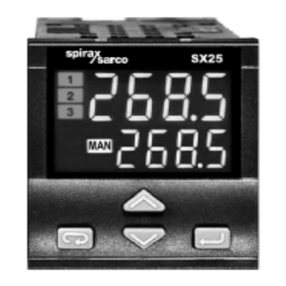
Spirax Sarco
Spirax Sarco SX25 Series Installation and maintenance instructions

giulio lighting
giulio lighting LC-001 user manual

Regin
Regin Optigo OP5U manual
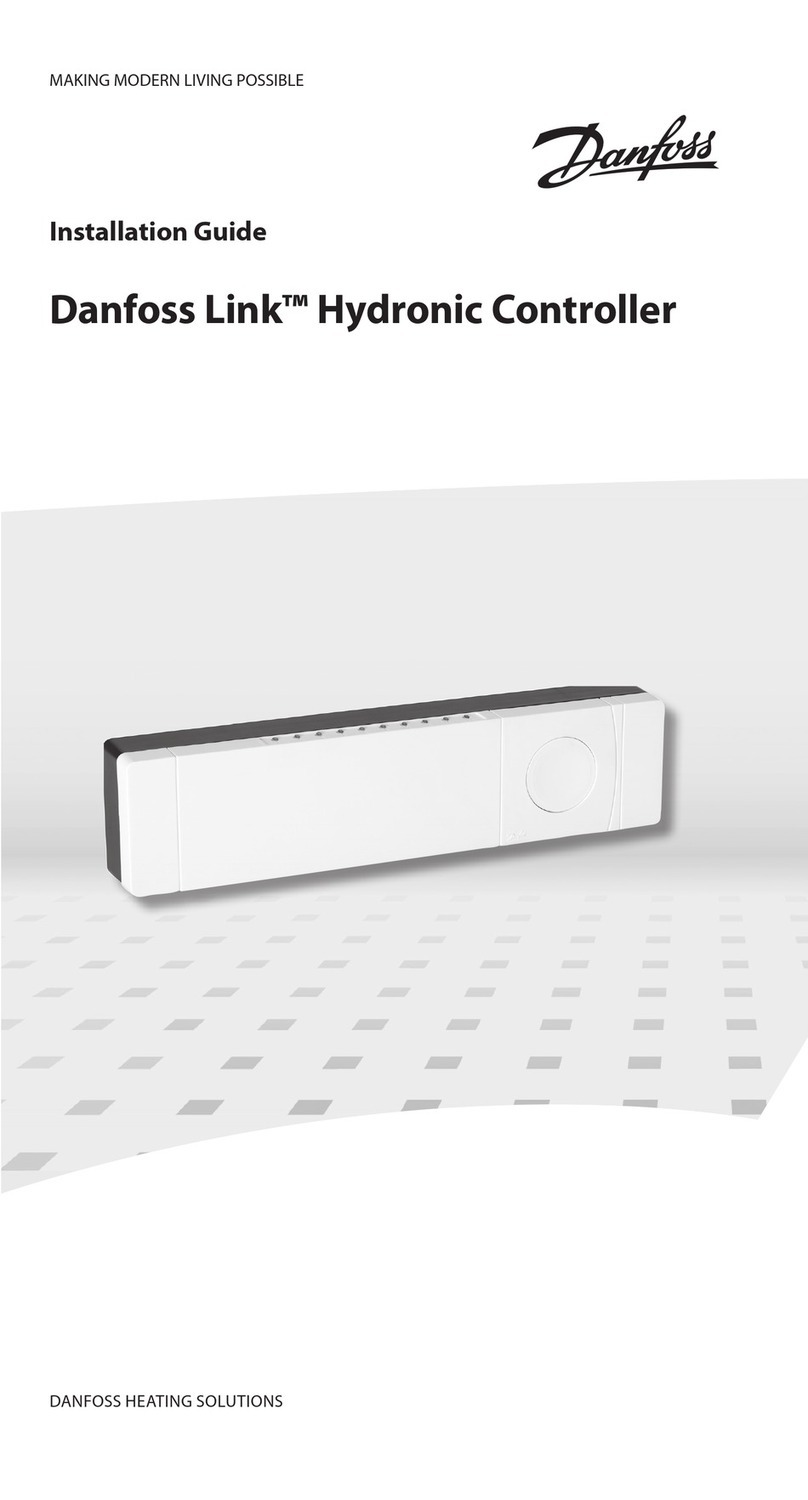
Danfoss
Danfoss Link Hydronic Controller Installation

Moore
Moore 535 PROFILER user manual
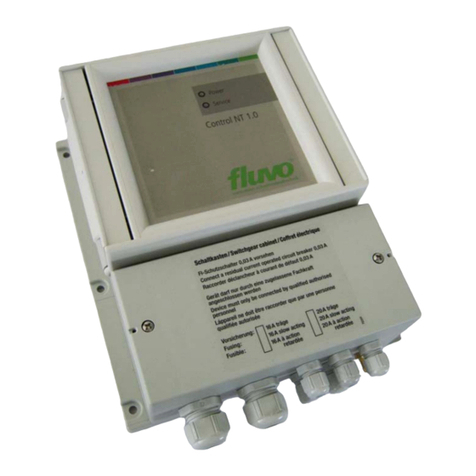
schmalenberger
schmalenberger FLUVO Control NT Operator's manual
